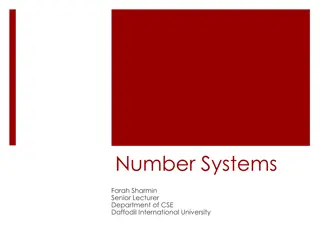Number Systems In History
Civilizations throughout history have expressed their values and beliefs through various creative forms like architecture, music, and literature. The development of numbering systems played a crucial role in advancing society's ability to communicate, track records, and engage in trade. From the early stages with figures like Ötzi the Iceman to the sophisticated Babylonian and Mesopotamian systems, the evolution of number and writing systems has been integral to the progress of human civilization. This article explores how these systems emerged and influenced the growth of ancient societies.
Download Presentation

Please find below an Image/Link to download the presentation.
The content on the website is provided AS IS for your information and personal use only. It may not be sold, licensed, or shared on other websites without obtaining consent from the author.If you encounter any issues during the download, it is possible that the publisher has removed the file from their server.
You are allowed to download the files provided on this website for personal or commercial use, subject to the condition that they are used lawfully. All files are the property of their respective owners.
The content on the website is provided AS IS for your information and personal use only. It may not be sold, licensed, or shared on other websites without obtaining consent from the author.
E N D
Presentation Transcript
Number Systems In History Civilization as we know it consists of creative expressions of value and beliefs through various forms: architecture, music, poetry, literature, painting, sculpture, language, cuisine, ceremonies and traditions, all of which are passed through the ages. Without a numbering system, and its alphabetic corollary, such civilizations typically fail to reach their limits of expression at a given level of technology.
tzi the Iceman In 1991, two climbers in the lower Alps discovered a body frozen in the snow. Thinking it may have been someone who recently died in a snowstorm, they called local authorities, only to discover that tzi was a well-preserved hunter who was born around 3275 BCE and died on the slopes around 3230 BCE at the age of 45 years. Studies revealed he embodied sophisticated knowledge of Neolithic farming, copper tools, and clothing from the Bronze Age, and some 680 years before the construction of the Great Pyramid at Giza, Egypt. We know nothing of his speech, nor any evidence of written language, and can only surmise that he had rudimentary knowledge of number systems, as evidenced by pollen samples of wheat, meat, and his copper axe that would have required some command of measurement. Beyond the Alps lay the Cradle of Civilization that would flourish with the birth of animal and plant domestication, and the evolution of the first numbering systems to track the seasons, merchant trading, and elementary astronomy.
The Fertile Crescent and the Origins of Number and Writing Systems The Neolithic Age, from 10,000 to 4,000 BCE fostered the mastery of plant and animal domestication, metallurgy, and the origins of written language and number systems. While pictographic writing would evolve in Egypt and China, it was from the Sumerians that the cuneiform system of writing lent itself to the evolution of accounting and early mathematical formulations
Babylonian Numbering Opens a Door In ancient Mesopotamia, the invention of cuneiform allowed the tracking of records of trade, taxes, and other accounts that were essential to the creation of a social order. While the Chinese would develop paper and the Egyptians would develop papyrus for writing, the Sumerians did their writing on clay tablets. Of several thousand that have been preserved, most reflect accounting records dating as far back as the end of the 4thmillennium, that is, around 3,000. It was not something known to tzi and his contemporaries in the Alps of Europe at the time, nor would it be adopted there during the course of history.
Mesopotamian and Egyptian Number Systems Cuneiform writing lent itself more readily to abstraction while Egyptian hierarglyphic writing was more limited. The transition from counting systems to elementary mathematical formulations thus progressed at a faster rate in Mesopotamia than in Egypt. For a while, neither cuneiform nor hierarglyphic systems contained the number zero. That would come as a contribution from the Indian mathematician Brahmagupta in the seventh century CE and was popularized by the Arab mathematician Mohammed ib- Musa al-Khowarizmi around 773 CE. It was from the Arab transmission of classical knowledge that led to the creation of the legendary libraries at Cordoba in Spain, and the Palace of Wisdom in Baghdad. While the manuscripts are Cordoba were largely preserved, the Mongol sack of Baghdad in 1258 resulted in the total loss of documents at the Palace of Wisdom. The Maya would incorporate zero in their own system of accounting centuries later and independently of its development in Middle Eastern mathematics.
Calendars and the Evolution of Civilization While number systems were important to the expansion of trade and accounting, the growth of agricultural knowledge depended in part on the formulation of seasonal calendars. The earliest known calendars date as far back as 11,000 years and took the form of megalithic structures to mark the vernal and autumnal equinox, and the summer and winter solstices. Calendars preceded the evolution of writing and number systems. They simply took into consideration when the son rose and set throughout the year, with a basic observation of the shortest and longest days of a year. The concept of a year was transmitted largely through oral tradition until written calendars could benefit from number systems and writing had evolve. Stonehenge, near Salisbury, England, is a late Neolithic megalith dating to 2,500 BCE, 730 years after tzi perished in the Alps. We have no evidence of writing a number systems in play at that time. Independently, the Maya developed their calendar dating to 3,114 BCE. While both civilizations linked calendar seasons to religious ceremonies, they played a practical role in assisting in the planting and harvesting cycles essential to settled agriculture.
A Lemma on Language In the hierarchy of human communication, art preceded written language. In the southern village of Lascaux, four teenage boys discovered the cave in 1940. Later studies revealed the estimated age to be between 15,000 and 17,000 years old. These images were created after the extinction of the Neandertals some 40,000 years ago. However, in 2017, scientists discovered a painting of a pig in an Indonesian cave, estimated to be 45,000 years old. This would have overlapped with the still extent Neandertals, and Homo Sapiens populations spreading across the world from the earliest known ancestors that migrated from East Africa. Donald Johanson and Maurice Taieb s 1974 discovery of Lucy in 1974 set a marker of evolution dating some 3.2 million years.
From Art to Pictographic Language Today, pictographic languages are found essentially in East Asia. They include Chinese, Japanese, and Korean. Over time, these pictographic language systems evolved alongside mono-syllabic systems: Katakana and Hiragana in Japan, Devanagari in South-East Asia, Centuries ago, hierarglyphic pictographic language emerged in ancient Egypt but gradually died out in favor of mono-syllabic language. From the ancient cuneiform language of Mesopotamia came the oldest world of fiction, the Epic of Gilgamesh, composed approximately in 2,100 BCE in the Akkadian language. As alphabetic languages spread, more written literature both mythic and historic were created. The Greek writer Homer composted the Iliad and the Odyssey dating to 725-675 BCE, while the Greek historian Herodotus wrote his Histories approximately 425 BCE. The mix of poetic, fictional, and non-fictional accounts formed the basis of narratives shaping the national identity of various civilizations. Translations and reproductions were rare until the innovation of paper and printing that provided a basis for cultural globalization that would flourish in centuries to come.
Paper and the Formation of Libraries The ancient Egyptians first developed papyrus writing as far back as 3000 BCE. Scrolls documented legends, dynasties, and major events. Reproduction was limited to the speed with which scribes could copy a papyrus document. The legendary library at Alexandria, Egypt was established during the reign of Ptolemy II around 285-246 BCE, and consisted of key works of world knowledge drawn from Alexander the Great s conquests of the eastern Mediterranean as far east as India. It consisted of some 40,000+ scrolls, equivalent to some 100,000 books, making it the largest known library at the time. During the Palmyrene invasion of Egypt between 270 and 275 CE, the library was destroyed. Only when the Arabs established the Palace of Wisdom in Baghdad in the late eighth century CE was there a gathering of literary, scientific, and historical works comparable to the library at Alexandria.
Printing on the Move China, which had developed paper, was one of the first countries to develop wooden block printing. With the earliest known examples dating to before 220 CE, by the seventh century CE, woodblock printing remained a primary method of printing images and text until the 19thcentury. The process of preparing woodblock prints was slow and laborious and resulted in a more limited distribution of texts. In turn, this system resulted in a slower rate of literacy expansion in China. When Mao Tse Tung established the Communist regime in China, efforts were made to adopt a Latin alphabet system to accelerate literacy. It was later abandoned, in part because digital technology interceded in a way to allow the pictograph system to continue, much as it has today, and based on primary binary code where digital technology has been embraced.
The Evolution of Arabic With the expansion of Islam throughout the Mediterranean and into Europe following the death of Mohammed in 632, various populations learned to speak and read Arabic, primarily through the study of the Quran. While Arab scholars undertook manual copying of the Quran on parchment, a Tajikistan letter in Arabic written on paper was first discovered in 1947. It dated to the middle of the 12thcentury CE. While wooden block printing in Arabic was adopted from Chinese, movable type printing invented by Johannes Gutenberg in 1440 would soon outpace the volume of printed texts in Arabic. Gutenberg s success was aided by choosing the Bible as the first text, which guaranteed a successful market. When movable type printing was tried in the Ottoman capitol of Istanbul in 1494, and later expanded in 1729 to non-religious texts. The problem with movable type Arabic is that it did not have a non-cursive script at the time and soon after the printing of the Quran with movable type it was abandoned. Thereafter, the Latin alphabet came to predominate the publication of books and manuscripts in the fields of fiction, and non-fiction science and history, first in Latin, and quickly in the secular languages of Europe. As a result, literacy rates in European countries began to outpace those in East Asian pictographic tradition countries as well as in the alphabetical world of Islam, Hebrew, Aramaic, Ge ez and related Middle Eastern languages. Between 1727 and 1838 a combined total of 142 books in either native Ottoman Turkish or translations were published. This marked a rising gulf between the level of scientific and historical knowledge in an expanding Europe relative to the Ottoman empire, and as an echo of the experience in pictographic language countries of the far East.
Number Systems Spur the Growth of Science Geometry, the measurement of distance, shape, size, and relative position is, after basic numbering systems, one of the oldest branches of mathematics. Algebra, trigonometry, and calculus are its linear descendants out of which most of our contemporary notions of understanding the universe are derived. Geometric formulations date back to the foundational civilizations in Mohenjo-Daro in the Indus valley and in the Euphrates of the ancient Mesopotamians. In 1894, a French archeologist discovered a cuneiform clay tablet that measured the dimensions of a property owner. Dating to between 1900 and 1600 BCE, the tablet displayed a series of triangles to execute the calculations. While side measurements conformed to the standard 180-degree area of a triangle, it would only be under the Greek mathematician Pythagoras (570-495 BCE) that the solution to the length of a hypotenuse would be established as the square root of the sum of squares of each opposing side.
Mathematics in the Building of the Egyptian Pyramids The ancient Egyptians are known to have constructed at least 100 funereal tombs to honor and send their Pharaoh rulers to the next life. The largest pyramid, that of Khufu (2,575-2,465 BCE) )was built between 2,550 and 2,490 BCE. According to the Greek historian Herodotus, it took 100,000 men 20 years to complete the monument, with each of the estimated 2.3 million stones weighing typically 1.16 tonnes. Elaborate tunnels leading to the burial chamber were built with knowledge of the weight-bearing properties of the stones. The base was 14.4 centimeters on one side compared to the adjacent side. While some have contended that the Egyptians used the Pythagorean theorem, there has been no evidence to substantiate this claim. As a result, the Egyptians were less adept than the Greeks in applying geometry to measuring the earth and the planets.
Beware of Greeks Bearing Strange Gifts Image result for pythagoras definition Image result for image of eratosthenes Pythagorean Theorem Lesson for Kids: Definition Examples | Study.com Pythagoras (570-490 BCE), the ancient Greek mathematician and philosopher, refined our notions of plane geometry with his famous measurement theorem on the length of the hypotenuse of a right triangle. He went on to make other discoveries, including the sphericity of the earth. Contrary to many who came to think the ancients believed in a flat earth , Pythagoras set the stage for the measurement of the earth s circumference by Eratosthenes (276-194 BCE) almost three hundred years later. His lower estimate of 40,250 kilometers (25,000 miles) turned out later to be within one percent of the earth s actual circumference of 40,096 kilometers (24,901 miles). The significance of this measurement is that it represented a first step in measuring distances in the galaxy, against which future generations could develop laws of motion from which we now build telescopic and space travel technologies to explore the universe.
From Two to Three-Dimensional Geometry Euclid (325-265 BCE) built on the foundations of the mathematics of Pythagoras to explore and classify geometric measurements from plane (or two dimensional) objects to solid (or three-dimensional) objects. His text, Elements, published in 300 BCE, stood the test of time as a principal source on the foundations of mathematics for centuries. It consisted of thirteen volumes and covered most of the known aspects of mathematics at the time. Euclid was the first to define the golden mean proportion of 1.61, and which some have ascribed as influencing Phidias (490-430) design of the Greek Parthenon temple constructed over a century earlier in 447 BCE. Phi may have been a known number before Euclid and he simply gave it formal definition that would be a key to architectural and painting proportions, to configurations in nature, as well as its later formalization by Leonardo of Pisa (1170-1250 CE), also known as Fibonacci.
Archimedes, Pi, and the Foundations of Engineering Archimedes (287-211), a Greek mathematician living in Syracuse, Italy at the time of the Roman Republic, combined knowledge of solid geometry with gravity. An object that is partially or totally immersed in a fluid is lifted up by a force equal to the weight of the fluid that is displaced. This is the basis of density and specific gravity essential to physics and engineering. His design of a screw is a form of a positive displacement pump. Medieval waterwheels, screw propeller ships, and airplanes all owe their origins to his original insights on fluid mechanics. His discovery of pi, the ratio of the circumference to the diameter of a circle is a mathematical constant used to examine properties and solutions for many problems in mathematics and physics.
The Eclipse and Rebirth of Classical Numbers and Language Greek civilization reached a pinnacle in the Fifth Century BCE. It was at that time when the writings of Socrates (470-399) BCE, Plato (428-348) and Aristotle (384-322 BCE) laid the foundations of western philosophy that would so influence the evolution of later civilizations. Faced with how to establish governance, the Greeks formed coalitions to fend off the Persians in the Battle of Marathon (490 BCE), then Thermopylae (480 BCE), and finally Salamis in the same year. However, internal divisions led to the Peloponnesian War (431-404 BCE), described in detail by the Greek historian Thucydides (460-400 BCE), and which foretold the collapse of Greek power and the ascendance of the Romans. From an early Republic, Rome evolved into an empire with vast control of the Mediterranean until its eventual fall in the fifth century CE. While the Greeks made pioneering developments in geometry, geography, and astronomy, the Romans built a system of laws. However, neither developed a more precise numbering system. The introduction of zero and decimal fractions would only emerge with the rise and expansion of Islam in the seventh century CE. And in turn, the Arabs in Andalusia would transmit classical Mediterranean Greek learning once again into Europe.























